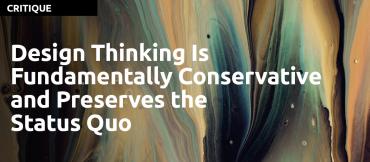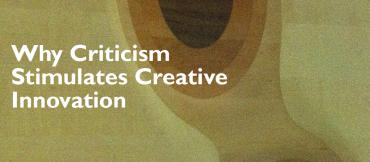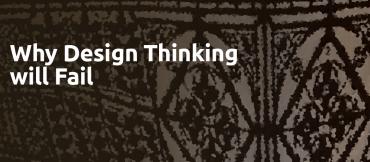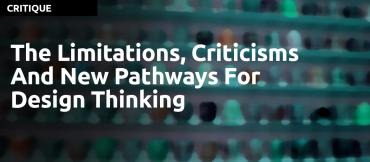
Articles about Design Thinking criticism provide rigorous examination and deep thought about the ideas, process and methodologies used in Design Thinking which help practitioners to think about and advance the practice of Design Thinking.
The goal of this Design Thinking criticism section is to provide articles with a depth of thought about Design Thinking for those who are interested in advancing their understanding and practice. Design Thinking criticism plays an important role in helping to raise the standards of practice across the discipline.
Design Thinking has come a long way in the last 20 years, but a number of criticisms have been leveled at Design Thinking by prominent thinkers and practitioners in critical articles by well known practitioners such as Tim Brown, Roger Martin, Natasha Jen, John Kolko and many more.
At school, designers subject their work to criticism by their peers and professors. Design Thinking criticisms form a critical way in which designers learn the craft of design and are meant to help practitioners see the aspects of their ideas and areas of their process and craft that need improvement.
In addition to helping to improve the process, articles that cover Design Thinking criticism can play an important role in improving the value of a raw idea and enriching its usefulness. During brainstorming sessions, judgement and criticism are suspended, but after that phase, it is vital to be very critical of the ideas and process to evaluate them in terms of their fit and desirability as a solution to the problem at hand.
As an association, we value the learning one can extract from disciplined critical thought and welcome your Design Thinking criticism articles.
Please submit your Design Thinking criticism articles for publication.
Design Thinking Training
Design thinking training has become increasingly popular in recent years, with businesses and organizations around the world looking to develop their innovation and problem-solving capabilities. While design thinking can be a powerful tool for creativity and innovation, there are also some potential pitfalls and limitations to its use. In this article, we will critically examine design thinking training, looking at its strengths and weaknesses, and providing recommendations for how to make the most of this approach.
Design Thinking Certification
Design thinking has emerged as one of the most popular frameworks for creative problem-solving. It has been used by businesses, startups, and non-profits around the world to develop innovative solutions to complex challenges. As a result, the demand for design thinking certification has increased significantly. However, the question remains, is design thinking certification necessary, and does it truly add value to the process of design thinking?
The Double Diamond Design Thinking Methodology
Understanding what has been missed in translation.
Method design experimentation can be wonderful and what we find often missing from this particular exploration is any kind of meaningful historical context. To coin a popular knowledge management community phrase; it seems that often the Double Diamond experimenters do not know what they don’t know in terms of methods history.
On Design Thinking
Design Thinking is dead — so the majority of my peers claim — yet there it is, smeared all over LinkedIn, peeking out from job descriptions and lurking in resumés. It crops up in conversations, sneaks into pitches and elbows its way into briefs. It graces the covers of the magazines which languish in shabby wire racks in my local supermarket.
In my close circle of well-dressed-folks-in-black, Design Thinking has rolled up and died somewhere, drowned under little squares of pale yellow paper, but out there?…
Design Thinking Is Fundamentally Conservative and Preserves the Status Quo
In this article Natasha Iskander argues that Design Thinking enables corporations to justify their risk averse decisions under the guise of a thin veil of understanding their customers needs. We call it design think washing! While this is an interesting critique, it misses the fact that it is not the methodology that is creating this problem as much as it is the way that it is being used. Design thinking should not be blamed as much as the people implementing the methodology. Natasha addresses that in a sort of rant against designers being the gatekeepers. Well,...now that is a turn around. Generally it is some middle manager who is responsible for the gateway, not the designer, so this is perhaps a little breakthrough here.
Design DNA: The Perils of Design Thinking
Design thinking attempts to explain a design process to non-designers before their attention span runs out. It takes too long to include an explanation of the other influences that make a great design, and designers—let alone anyone—have a hard time articulating such nuances, especially before the audience is lost...
...Designers don’t start out being able to see, record and then wield information, even after a $199 online crash course in design thinking. It takes years of practice and experience to become good at it.
The Craze for Design Thinking: Roots, A Critique, and toward an Alternative
Favoring orientation to and the participation of design users in the design process, Design Thinking (DT) has a long lineage. With the Cold War's end, the Internet's rise and Stanford University's turn to teaching DT (2005), this 'bottom up', demand-driven conception of design gained new adherents, going on to win mainstream status when advocated in the 'Harvard Business Review' in 2008. While some managers, especially in government, have since adopted DT rather uncritically, it has prompted a schism in design circles - one as grand, perhaps, as that between post-Modernism and Modernism.
Design Thinking: A Useful Myth
A powerful myth has arisen upon the land, a myth that permeates business, academia, and government. It is pervasive and persuasive. But although it is relatively harmless, it is false. The myth? That designers possess some mystical, creative thought process that places them above all others in their skills at creative, groundbreaking thought. This myth is nonsense, but like all myths, it has a certain ring of plausibility although lacking any evidence. Why should we perpetuate such nonsensical, erroneous thinking?
Methodology Ethics: Embracing the New Era
The topic of community ethics is a rather dry but important one and I was somewhat surprised by the focus of that Design Thinking group thread in which these questions were initially asked: “What is the ethical grounding of design and design thinking? This includes what work one chooses to do as well as how one approaches the actual design. Are designers responsible for the ethics of their [output] designs?”
Why Design Thinking Workshops Don't Work
What is sold as Design Thinking often has little to do with the actual methodologies. Here’s what to look out for, to do it right.
Peer Review Series: Review #1 of 10. IBM Design Thinking
Racking up more than 500,000 views on YouTube this video was chosen as the first in our ten part experimental review series due to its high public visibility and its emphasis on methodology being depicted as “Design Thinking”. Is this document adding to the clarity or the confusion around Design Thinking?
What They Don’t Tell You at Your Design Thinking Training
The Design Thinking hype has even come to a point where there are people starting to wave red flags. I might be one of them. Sometimes. However: I’ve told myself to be optimistic about it all. In true designers fashion we need to look for the opportunities, the added value. Not debating who’s right, and who isn’t.
Why Design Thinking Initiatives Fail
Once upon a time, design thinking offered hope. It proposed a radical shift in how organizations both understood the people they served and the way in which they conceived, designed, and developed new ideas to serve them. This promise is why organizations believe the adoption of design thinking is an endeavor worth investing millions of dollars and thousands of hours on.
Optimism and Critique
When I was at art school the critique was central to the ethos. Every couple of weeks I would have to pin my work up on the wall and defend it from the criticism of fellow students and professors. It was always stressful but as long as I hadn't made the mistake of staying up all the previous night trying to get the work finished I normally performed OK.
Why Criticism Stimulates Creative Innovation
Many business leaders fear criticism. They’ve heard that openly critiquing ideas and work product can stunt creativity, but nothing could be further from the truth. It turns out that criticism and debate – when delivered appropriately – can drive creative innovation and encourage team members to perform optimally.
Recent research by Charles Nemeth, a professor of psychology at the University of California, Berkeley, shows that criticism may play a productive role in driving creativity.
8 Design Thinking Flaws and How to Fix Them
Because people can quickly understand the power (or promise) of Design Thinking, companies, consultants, and universities have latched on to the methodology and quickly accelerated it to the top of the hype curve. This has created a lot of problems for both expert Design Thinking practitioners and for the methodology itself.
Why Design Thinking Will Fail
Not living up to the hype will be the cause of failure of Design Thinking as the sought-after innovation process...The term Design Thinking has become such a buzzword over the years that its meaning has become diluted by being overly and loosely used by amateur designers and business thinkers.
The Divisiveness of Design Thinking
In this well balanced article author and designer Jon Kolko takes a look at some of the reactions from the design profession against the present form of Design Thinking and attempts to build a bridge between the business and design perspectives on Design Thinking.
What Makes a Knowledgeable, Talented and Skilled Designer
The profession of Design is still relatively young. It originated from the creation of a product’s appearance, and the touchpoints where that product was exposed to customers.
Read Yasu's feature article published by the Design Council.
Six Questions for Design Thinkers
Natasha Jen of Pentagram asks Design Thinkers to prove that the process works by asking them to think about what they are doing by posing six questions. This talk is a follow up to an earlier talk she gave at the Adobe 99U entitled "Design Thinking is Bullsh*t!"
The Limitations, Criticisms and New Pathways for Design Thinking
As I found out from my research, there is an awful amount of “noise and hype” to work through to find the past, present and future positions of design thinking. In summary, I think design thinking is undergoing a revolution, a certain maturing but it is littered with a very messy, highly competitive present.





















